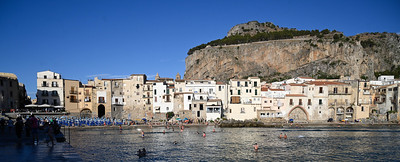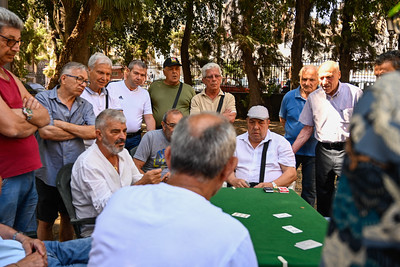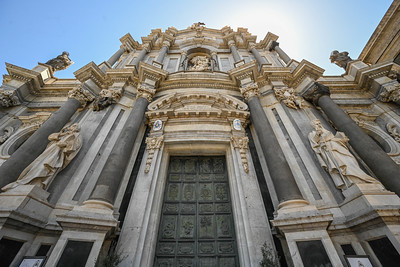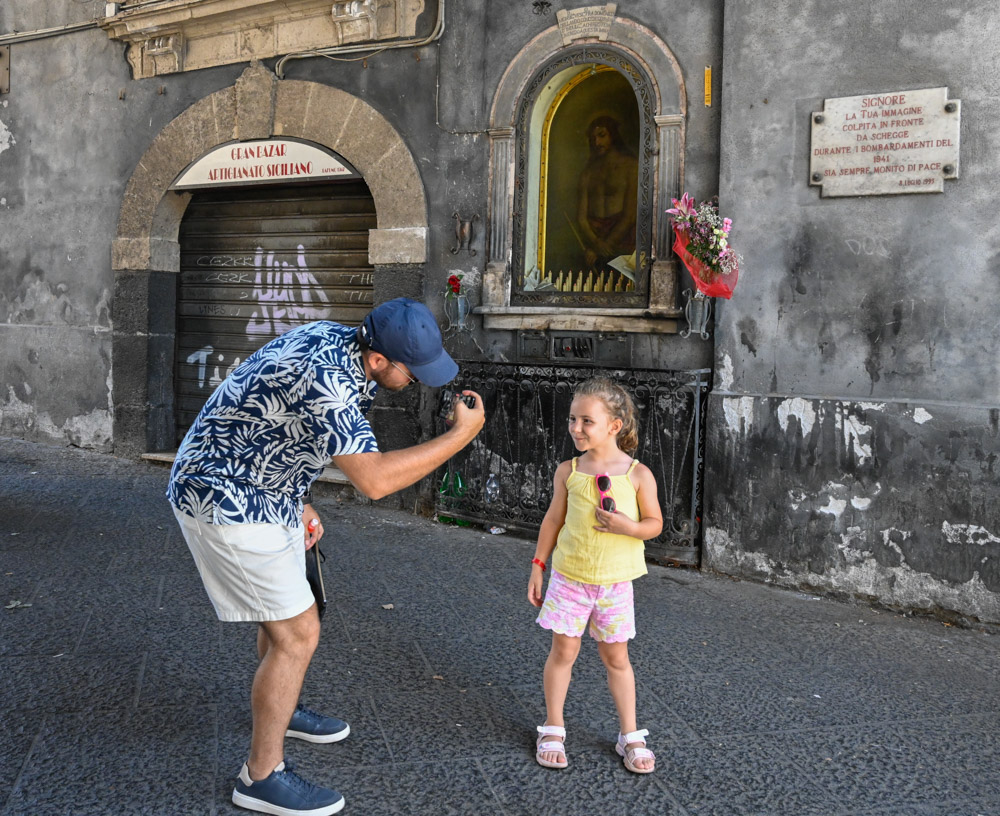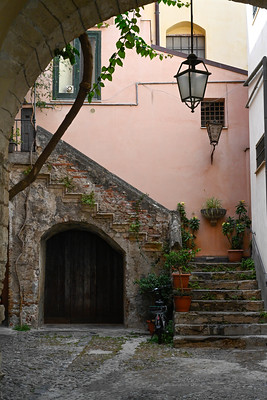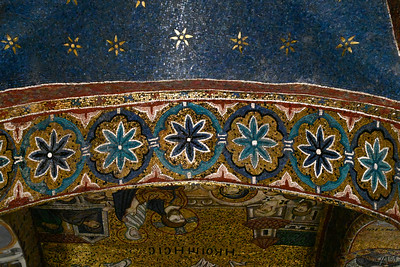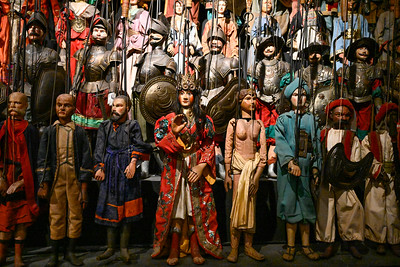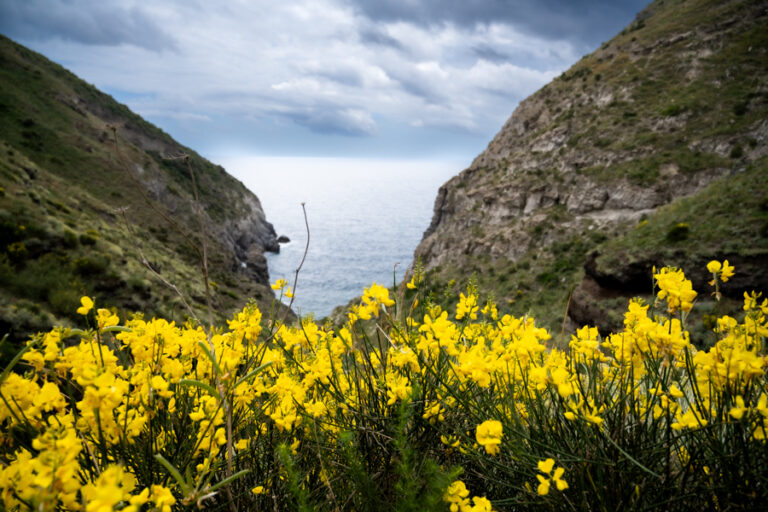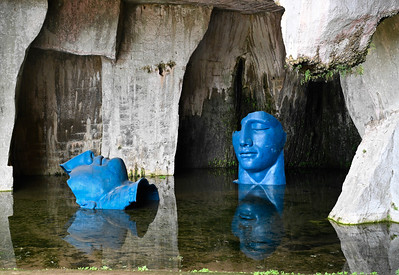Viaggio in Sicilia / 10: 23 giugno – domenica
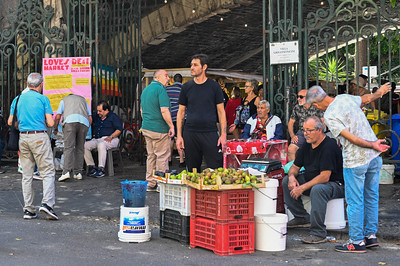
We left Siracusa early and, en route to Cefalù, maneuvered our way to park near Catania’s Porta Uzeda then wandered the streets of what was, for a Sunday morning, and unexpectedly vibrant and pleasant city, with streets and plazas abuzz with vendors and people out for a stroll, the park near the entrance through the city walls filled with elderly card-playing fellows.
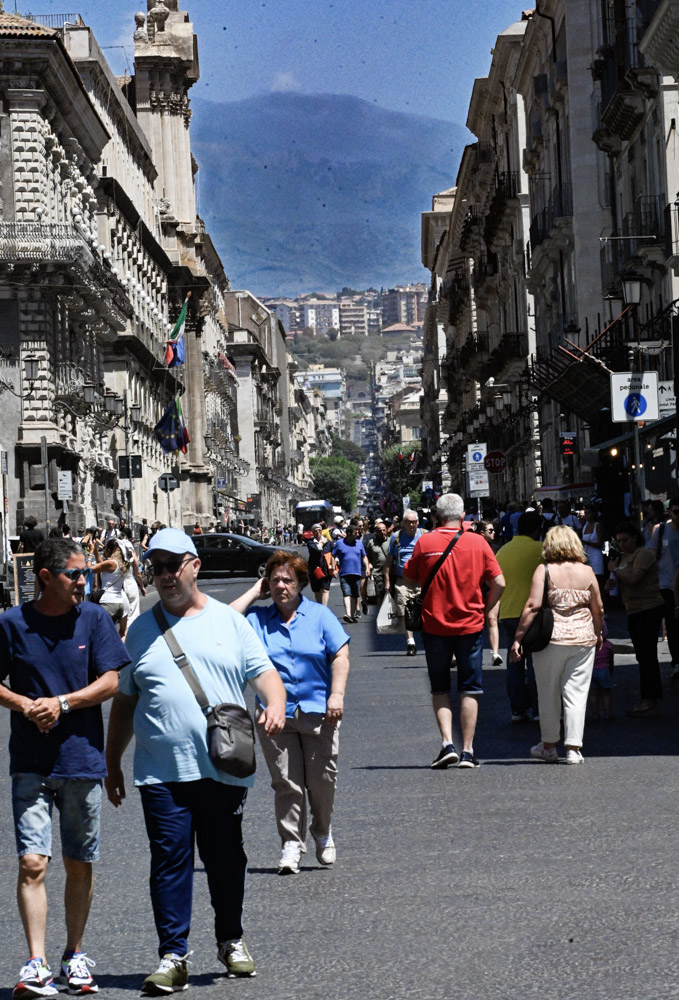
Our walk through the palace and church-lined rectilinear grid of Catania’s oldish core exposed us to a the city’s uniquely charming if not sill gritty core. The black (volcanic) façades trimmed and scored in white limestone, the broad and airy rectangular squares all give this city an open, orderly and elegant feel… yet another example of the showy splendor of a class (the modern bourgeoisie) and community that seem to look on change, on time passing, with a degree of haughty indifference… just as does Mount Etna, towering high above the skyline, looking askance upon humanity’s material aspirations, upon Catania as a monumental exercise in vanitas.
In some way, more than all of this seemingly tarnished elegance, erected anew after the last in a long series of natural disasters (eruptions, earthquakes), it was the gritty, working class Catania of the fish market area –its hustle and bustle flowing along narrow and grimy cobblestone biways, a neighborhood that lies in the shadows of Catania the aristocratic/Catania the canonical… this was the Catania that somehow seemed more authentic and timeless. This was the Catania that spoke to our heart more than to our head, that spark our morning walk around the city. A delectable fish-lunch at Scirocco’s, street-side with the city’s energy at 10 and the charming immigrant waiters hover around and reminded us of the most meaningful ways in which such communities can really renew time and again…
From fish to car and on to Cefalù, at the end of what would be the longest leg of our journey. Arrival and parking in the centro storico parking lot was fairly uncomplicated. Despite it being Sunday, we arrived late enough in the afternoon for the day-trippers to begin abandoning this city and freeing up spots. And then there is GPS… Maybe only the dinosaurs among us now remember travel in the pre-digital age. We may have had to rely on more primitive resources, like our brains, but, then again, there were far fewer travelers on the road and at these sites, and, well, maybe proportionately more brains? I wonder to what extent this digital age of ours has become a brainless age… a trap devoutly to be avoided!
Our stay at Cefalù opened with my carting both suitcases up three interminable flights of narrow stairs (yes, Rick Steves, you warned me!) –with a firmly proclaimed proviso at the bottom of the stairs “No complaining!”– to reach the lovely Scirocco BnB on Cefalù’s Piazza Garibaldi. Scirocco and Garibaldi are ubiquitous qualifiers in Sicily, just like cannoli, cassata, and caponata. (Many great things start with the letter “c” in Sicily, like catarrato, cunzato and Cefalù!) This Scirocco has a nicely maintained kitchen, with homemade cakes compliments of Nicole’s mother, and a beautifully furnished rooftop with views above the old town and out to the sea. After catching our breath and washing off the sweat, we set out on a restorative lungomare walk around Cefalù’s old town and marveled at the exceptional charm and beauty of the city, the hoards notwithstanding. Seeing Sicilians enjoying Cefalù’s waters and wonders was truly moving.
Here Rick Steves proved once again to be particularly useful. Without his guide we would have missed the medieval laundry and the Fishing Net Workshop (the Associazione Cultural RicamArte). We might not have strolled out through the Porta Pescara and out to the end of the peer. His photo of kids jumping into the sea was inspirational. It is always so comforting when a guide book can train the eye in these subtle ways.
The next morning we followed R. Steve’s advice in visiting the Mandralisca Museum and were treated not only to Antonello da Messina’s “Ritratto di un uomo” but also Giovanni Antonio Sogliani’s “San Giovanni Battista.” We also used his guide to read deeply the remarkably complex kaleidoscope of mosaics inside Cefalù’s duomo. Ah, that Panocrator, the king of all that is uniquely intercultural, the unique mélange that defines Sicily –Phoenician and Greek, Greek and Roman, Arab/Byzantine/Norman with a think layer of Spanish icing for good measure. I have a strong predilection for the Byzantine, the oriental splendor that shines through the magical brilliance that defines Sicily’s Pantocrators, unique within Italy, a sign of Sicily if not the Mezzogiorno’s distinctive easternness.
Here I have broken with the chronological rigor of these reflections, following Rick Steve’s narrative into Day 11 (June 24, Monday), the morning of our return to Paleerm. But before foraging ahead into that thread, I should return to the evening of Day 10 (June 23) to record as well that were it not for Rick Steves we would not have stopped to marvel at Piazza Marina and to recreate in our imaginations, over the din of the music and crowds, Cinema Paradiso’s final scene, filmed in that piazza: the outdoor cinema improvised on the white wall of a building overlooking Cefalù’s port as the sun began to set over the horizons.

We topped off our magical mystery walk around Cefalù with an aperitivo by the sea then dined near the bastione di Capo Marchiasava, at Al Porticciolo, before heading back along the beautifully illuminated Corso Ruggero, Cefalù’s main street, to our BnB in the heavens (a few steps beyond the purgatory of three flights of stairs!), where Augusta crashed and I went up to the rooftop to marvel at what beauty there is in the stones, stars and the sea.
Photo album available on Flickr at: https://flic.kr/s/aHBqjChynS
